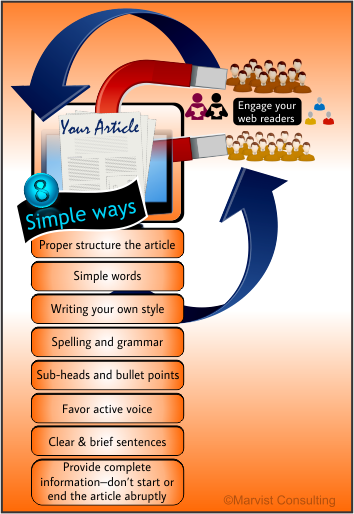Date Published: 6-Aug-2013 | Author: Kerry K Robinson
10, 9, 8, 7, 6, 5, 4, 3, 2, 1 – In these 10 seconds if your article couldn’t capture the attention of your reader, believe me the reader will be very unlikely to ever come back to your site. It’s true, readers take less than 10 seconds to decide whether to read the article or not. So, if you want readers to engage with your article and read the article from the start to the end, then your priority should be on good user experience, which means writing in a way that leaves the reader satisfied and convinced.
To help you understand how to write for web readers, we have listed below eight simple ways that will help you increase reader engagement.
1. Properly structure the article
 The structure of the article is very important. See that there is a logical flow across the article. Each paragraph should connect with the next paragraph. Similarly each sentence in a paragraph should connect with the next sentence. All the sentences in the paragraph should be relevant to the sub-head and to the title of the article.
The structure of the article is very important. See that there is a logical flow across the article. Each paragraph should connect with the next paragraph. Similarly each sentence in a paragraph should connect with the next sentence. All the sentences in the paragraph should be relevant to the sub-head and to the title of the article.
2. Use simple words
Use simple words. Simple words are more likely to convey your message to your readers easily. Besides, they make content interesting and understandable. Make sure to use commonly used words in place of complex words. As a rule of thumb, use English that an average educated person can read and understand. Don’t use any word that you are not comfortable with.
3. Develop your own style
Your writing style is likely to develop over time. You need to keep writing, keep reading and keep revising in order to improve and develop your writing style. Make sure you maintain a consistent writing style, so that the readers can recognize by reading your article that it’s written by you. Further, write in your own style taking care of your reader’s needs. See to it that it is engaging your readers.
4. Focus on the basics of grammar and spelling
Use correct grammar and spelling while writing an article. Grammatically incorrect sentences convey a negative impression on you as a writer and on your business. Your audiences may assume you are either careless while writing or you are a low level writer. Such an impression is harmful enough to make you less credible author.
5. Use sub-heads and bullet points
Readers will quickly scroll first to see if the data is worth reading and only after they are comfortable, they will start reading the article. Break the article into small paragraphs and each paragraph should not exceed more than four to five lines. Each paragraph should have a sub-heading and one main idea – only one. You can also add bullet points to make the article easier to read.
6. Favor active voice
Sentences in an active voice give an impression of your straightforwardness. Readers quickly understand sentences in an active voice rather than those in passive voice. Use active voice as much as possible.
7. Use clear and concise sentences
When it comes to writing content for the web, use sentences that are clear and crisp. You need to write your concepts, principles, gist, etc., with definitive terms; so that audiences can get the information and the clarity they are looking for. Remove unnecessary paragraphs, sentences and words.
8. Provide complete information – don’t start or end the article abruptly
One of the important things while writing content is to make sure that you provide informative content. Sudden starts or endings will confuse the reader. They will feel unsatisfied as your article did not provide the information it promised. Now they have to look for other sources to get clarity. It will give a very bad user experience.
You have to deliver whatever you promised in the title. For example, if your article title says ’10 Dog Grooming Tips’, make sure you provide 10 exact tips. Not 9 or 11. By giving the information that your article promised, it will leave a good impression on readers.
Web readers are a distinct set of audiences. Follow the above mentioned eight simple ways and start creating web articles to keep your readers hooked and returning for more.
You may also like to read:
